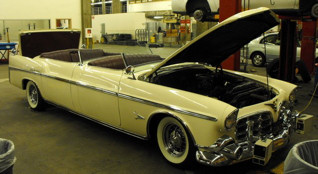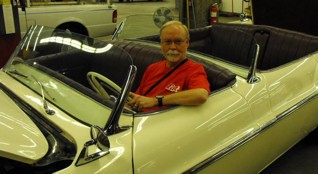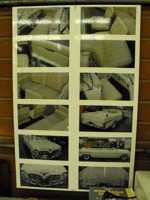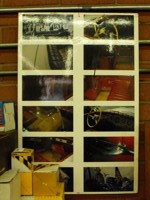
Los Angeles Imperial Parade Phaeton
by
John
Lazenby
Imperial
Home Page -> Imperials
Of Distinction -> Phaetons
-> 1950s
-> Los Angeles
|

In the downtown Los Angeles maintenance garage.
|

A long dream of sitting at the wheel of this great car becomes
reality.
|
The
Los Angeles Imperial Parade Phaeton
My story of
the Parade Imperials started when I was probably about ten years old.
I grew up with Chryslers and always considered their products the best
America
offered. For me the three Parade
Phaetons were and are the pinnacle of the Imperial badge.
About 1957 my parents took me to the
Los Angeles
County Fair at the
Pomona
Fair Grounds. An event occurred
while I was there that altered my automotive life.
We were walking down one of the main isles when security moved us all
aside and there it came. It was a
silver blue Imperial Parade Phaeton with then Vice President Richard Nixon and
his family riding in the back.
Most would be taken to see a person of such notoriety up that close, but not me.
It was the car that completely captured my attention.
It was the most magnificent automobile I�d ever seen and that moment
was frozen in my mind for life.
Over the years I�d read as much as I could find regarding these three cars and
their history an have now seen two of the three in person.
Maybe someday I�ll be able to view the
New York
car in person.
While researching these cars I came to appreciate the first rendition over the
current. Yes, I�m probably in the
minority on that, but I felt they were much more stately and graceful.
Fast forward to July of 2010. I had
taken our 1955 Imperial Newport
(/Yr/1955/JohnLazenby55/JohnLazenby55-01.htm)
to the local Garden Grove
,
California
Friday night Main St. Cruise. This
car is always a crowd pleaser and many ask questions and tell stories about
their experiences with that era of automobiles.
Click
any photo below for the larger version.
While there I was approached by a couple of guys and a lady.
The first fellow seems to have some knowledge of these cars and stated to
me that he had maintained the
Los Angeles
Parade Imperial for the past twenty years.
My first reaction, which I did not state verbally was, �yep, sure you
have�. I did think I�d challenge
this by asking �would it be possible to get a tour of the car�?
His reply was �sure� and we exchanged cell numbers.
I�m still not convinced that he is for real, but once he told me where
the car was it worked into some plans that were being laid at that time.
The fellow who was with him started to tell me there were four of these cars
made in
Italy
. I responded with, �To my
knowledge there were only three made in
Detroit
in 1951 or 1952 and then taken back in and re-bodied in the mid fifties�.
He was persistent with the four examples being built and then the lady stepped
in and backed him up. At that point
I didn�t want to be combative, but once he told me �the fourth one fell off
the boat when coming to
America
� I had to reply. I told him that
he could possibly be thinking of the Virgil Exner concept Norsemen that went
down with the Andr�a Doria.
/Articles/GhiaStory/Page04.htm
My next question was�
how one could fall off the boat�? Of
course he had no answer for this and quickly faded into the background.
|

|

|

|
|
These are photographs of the other two Parade Phaetons displayed over
the work area the L.A. car was placed. Possibly for some reference
material?
|
Moving forward a few days, I was waiting for a call from a friend in
Texas
who was planning on flying out and three of us were traveling to
Central California
to view a recently discovered car collection that had cars he and I were both
interested in possibly purchasing. A
few days later those plans were confirmed and I phoned the cell number provided
to make the arrangements to view the Phaeton.
On the morning of July 16th the three of us arrived in downtown
Los Angeles
at the designated time and location and were escorted in to a large garage
facility that maintains the city and county vehicles.
There it was, parked amongst mostly utility vehicles.
We were given access to any part of the car, which in our case meant all of it.
For about the next hour we discussed the car�s history and took photos.
The person in charge of this unique car became fascinated that we knew
much more than he did. He told us he
had been trying to research the car, but had no assistance.
All three of us left our contact information for his future needs.
One of my favorite things to say is �If the cars could talk what stories they
could tell us�. This example would
be over the top in that category I suspect.
I�m pleased that it has survived all of these years, but many changes and the
workmanship sometimes performed is rather sad.
We all took many photos of different aspects of this car and here are some for
your review. Oh, one last thing.
Our trip proved to be very worth while as we did purchase a couple of
cars from the collection, but more on this later.
Click
any photo below for the larger version.
|
Having trouble with printouts coming out way too
small, or pieces of a document printing acro ss
sev eral page s?
Then go to our
"How To Print
Imperial Literature" page to learn how to print an item at the size
you'd like. |
This page was last updated 27 December 2010. Send us your feedback,
and come join the Imperial
Mailing List - Online Car Club

